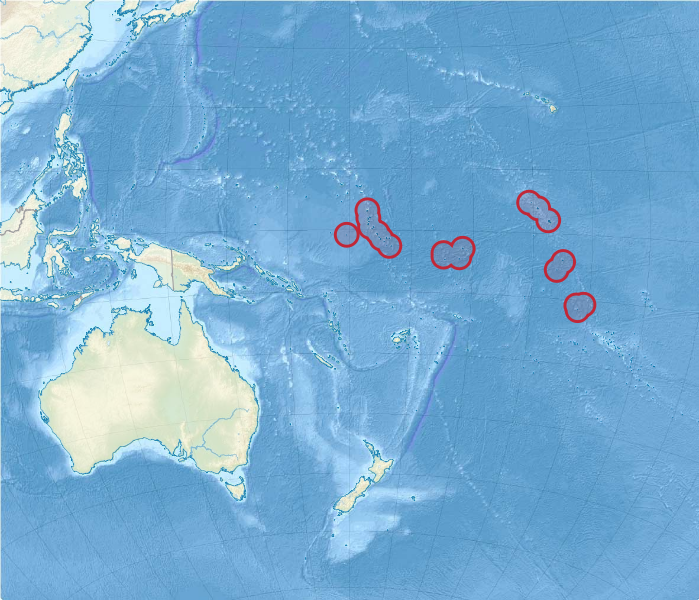Christmas Island
Wouldn't it be lovely to spend Christmas on a tropical island in the Pacific? This is what the famous English explorer James Cook and his crew did, when at Christmas time in 1777 they discovered a hitherto unknown – or so they thought – island in the Pacific and called it Christmas Island.

The island state Kiribati in the Pacific Ocean. Christmas Island lies in the group of islands furthest to the north-east. (Picture from Wikimedia Commons).
In actual fact the Portuguese explorer Hernando de Grijalva had already discovered this island in 1537 and christened it Acea so Cook was not really the first man on the island. Nor was Hernando de Grijalva for that matter either in all probability, for a few possible traces of early settlement suggest that the island was occupied before the European discoveries, probably between 400 and 1200. Christmas Island, however, was uninhabited when both de Grijalva and Cook came to it and no permanent settlement was established there before the end of 1882. Since that date there has been a permanent population on the island with the exception of the period from 1905 to 1912.
The island forms part of a so-called coral atoll and is today the largest of the islands in the republic and island state Kiribati, occupying almost half the total area of the state. Christmas Island is about 44 km wide and 39 km long. The highest point is 12 metres above sea level. The population consists mainly of Micronesians speaking Gilbertesian, also known as I-Kiribati.
Is Christmas Island really Christmas Island
As already mentioned the island was first called Acea by the Portuguese in the 16th century and it was not until James Cook's discovery of the island in 1777 that it received its lasting name Christmas Island. It was simply given this name because it was discovered on Christmas Eve. Because of the transparent nature of the name it soon received translated forms in a large number of languages. Île de Noël in French, Weinachtsinsel in German, Julön in Swedish and Juleøen in Danish. When the republic of Kiribati achieved independence from British sovereignty, greater stress was laid upon the employment of the Gilbertesian language and the island's official name is Kiritimati, pronounced [kǝˈrısmǝs].
When lands have once belonged to colonial powers, the earlier colonial place-names are often subsequently discarded. This has not taken place, here, however, since Kiritimati is simply the Gilbertesian translation of the word Christmas, as is revealed by the pronunciation. One must not be confused by the spelling, for the letter s does not occur in Gilbertesian and the s-sound is usually represented by the combination ti. This is perhaps less surprising than one might think in consideration of the way in which the combination ti is pronounced in English in a word such as nation [ˈneɪsjən].
The reason why it was decided to retain the colonial name with the pronunciation adapted to Gilbertesian is probably that the islands were not inhabited until in comparatively recent times. The present settlement is not much over a century old, and the fact that the name of the republic Kiribati (pronounced [kıribas]) is itself a Gilbertesian version of (part of) the island state's earlier name Gilbert Islands probably also played a role in the decision.

Air photograph from 1956 taken during one of the less fortunate episodes in the colonial period: when the island group was employed by both Britons and Americans for nuclear testing. (Illustration from Wikimedia Common)
Kiritimati or Christmas Island – which form should man employ? It all depends on the context. In actual fact one ought to use the state's own name-form, Kiritimati. and if possible with the native pronunciation [kǝˈrısmǝs]. That is at any rate the answer one would receive from the UN agency UNGEGN (United Nations Group of Experts on Geographical Names). It is their opinion that one should if possible employ only one name-form of a place-name and that this should be the name-form in the local language or languages, where a country has more than one language. The reason is that international communication would become easier if fewer forms of a name existed. In a purely English context, however, it is quite acceptable to employ the form Christmas Island until the modern official form has become familiar. It is also possible to employ both forms in order to make it easier for the official form to win acceptance.
Other Christmas Islands
It is actually a good thing that Christmas Island is now officially known as Kiritimati, since it is not the only island to bear this name. There is a Christmas Island in the Indian Ocean. This belongs today to Australia, and the population of approximately 1,500 live primarily in the northern part in the towns, Settlement, Silver City, Kampong, Poon Saan and Drumsite. The capital is called Flying Fish Cave. This Christmas Island has also taken its name from the date of its discovery. This was as early as in 1643, when the British captain William Mynors observed it on Christmas Day.
Yet another Christmas Island lies between Tasmania and the Australian mainland but this island is uninhabited. There is also a Christmas Island in Zimbabwe's sector of Lake Kariba. So it is no great loss to us that the official names of Christmas Island in the Pacific is now officially known as Kiritimati. We can still celebrate Christmas on one of the remaining Christmas Islands.
Kabaia Kiritimati – Happy Christmas!
Peder Gammeltoft
